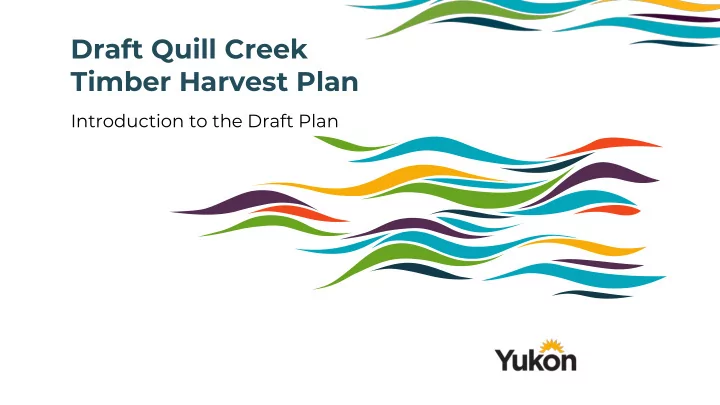

Draft Quill Creek Timber Harvest Plan Introduction to the Draft Plan
Champagne and Aishihik First Nations Final Agreement What is the • Chapter 17 provides for Forest Resources Management Planning • Role of Renewable Resources Councils in forest management framework and Forest Resources Act planning that has • Establishes the requirement for sustainable forest management been done leading up • Sets out planning regime, timelines and process requirements to this current CATT Strategic Forest Management Plan process? • High level, strategic goals and objectives for forest management • Balances forest use with long term sustainability • A collaborative process with strong implementation committments Integrated Landscape Plan The Champagne and Aishihik First • Identifies broad areas (zones) where timber harvesting can occur • Forest resources harvesting guidance in consideration of other Nation Final Agreement , and the values Forest Resources Act sets out the • Provides direction for forest fuels management for risk reduction process for sustainable Timber Harvest Plan management of forests in the traditional territory. • The purpose of a timber harvest plan is to identify the forest resources; objectives for timber harvesting; locations suitable for timber harvesting; and the location of existing and proposed roads. • Timber harvest plan must also include a description of the ecosystems, the value of forest resources to first nations and Yukon residents, and strategies to reduce adverse impacts to those values.
Strategic Forest Management Plan First Forest Resources Management Plan to be completed in the Yukon after Devolution Developed to address the spruce bark beetle infestation that caused extensive spruce mortality over 400,000 hectares. Plan was approved in 2004 with 4 main Goals: • Goal A: Functioning Forest Ecosystems • Goal B: Community Sustainability and Benefits • Goal C: Cooperative Forest Planning and Management • Goal D: Build Local Capacity
Strategic Forest Management Plan Planning Priority
Integrated Landscape Plan Plan was approved in 2007 and is a technical assessment of resources, management priorities and guidelines for timber harvest project planning • Provides Zonation for Timber Harvest Planning (“go” and “no - go” zones for planning) • Harvest Development Priority based on fire risk Zonation • Provides guidelines for Timber Harvest Planning
Integrated Landscape Plan - Zonation • Forest Resource Management Zone (FRMZ - Green) – this is where Timber Harvest Planning may occur • Provisional Forest Management Zone (PFMZ - Yellow) – This zone may be considered for Timber Harvest Planning once an evaluation of FRMZ harvesting success is completed and there is demand • Conservation Forest Management Zone (CFMZ - Orange) – This zone is not recommended for Timber Harvest Planning, however low volume activities may occur here
Draft Quill Creek Timber Harvest Plan • Located south of Haines Junction • Covers 11,596 hectare area • 32 Harvest Blocks • Primary focus of the plan is commercial fuelwood harvesting with fuel abatement the primary objective in 11 harvest blocks • Plan identifies approximately 164,000 m 3 of timber available for harvesting (72,400 cords) • Harvest blocks focus on stands with high rate of spruce mortality Government of Yukon 7
Quill Creek THP - Key Stats F ORESTED H ARVESTED P ROPOSED R OADS W ETLAND F ORESTED N O TOTAL H ARVEST H ARVEST ( HA ) Area 10,707 372 1,823 48.7 639 8,463 11,596 (ha) % of Area 92.3% 3.2% 15.7% 0.4% 5.5% 73.0% 100% E XISTING P ROPOSED L ENGTH C LEARED G ROUND L ENGTH C LEARED G ROUND ( KM ) A REA ( KM ) A REA D ISTURBANCE DISTURBANCE ( HA ) A REA ( HA ) ( HA ) A REA ( HA ) Roads 4.5 N/A 1.6 32.6 N/A 13.4 within blocks Roads 25.1 3.6 9.0 21.2 26.3 8.9 outside blocks Roads 29.6 3.6 10.6 53.8 26.3 22.3 total
Timber Harvesting In Haines Junction How much timber harvesting is there, what is it used for, and who is doing it?
What is the harvested wood used for? The vast majority of the harvested wood is being used to heat homes and businesses in the Yukon. A small percentage of harvesting is being used for building logs or sawlogs.
How much wood is harvested and what's the local involvement? • Timber harvesting in the CATT has averaged 12,600 m 3 /year (5500 cords) • Approximately 66% of commercially harvested timber has been cut by local operators • Average of around 25 active Licencees per year in the CATT • Majority of timber is harvested by the largest 2-3 operators This chart shows the amount of annual harvest by CATT residents and Yukon residents.
Timber Harvesting Selective deadwood harvesting; Fuel abatement
Fuel Wood Harvesting Selective Harvesting: • Prioritize the harvesting of dead timber • Dispersed and grouped retention • Retention influenced by mortality level
Fuel Abatement Patch Cuts with Retention: • Prioritize removal of timber for vertical and horizontal fuel continuity • Important to treat ground fuel loading • Encourage and promote Aspen/Poplar regeneration
Recommend
More recommend